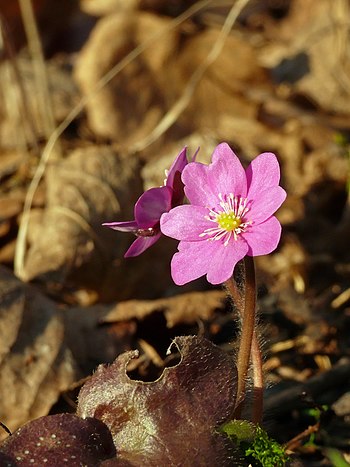Let us start off with March, the hepatica, spring beauty and saxifrage. Then comes April bearing in its arms the beautiful columbine, the tiny bluets and wild geranium. For May there are the dog-tooth violet and the wood anemone, false Solomon's seal, Jack-in-the-pulpit, wake robin, bloodroot and violets. June will give the bellflower, mullein, bee balm and foxglove. I would choose the gay butterfly weed for July. Let turtle head, aster, Joe Pye weed, and Queen Anne's lace make the rest of the season brilliant until frost.
Let us talk a bit about the likes and dislikes of a few of these plants. After you get started you can keep on adding to this wild-flower list on your own as you discover what plants grow well in your area and how they like to be treated.
| Hepatica nobilis. Purple form. (Photo credit: Wikipedia) |
You will find hepaticas growing in clusters, sort of family groups. They are likely to be found in rather open places in the woods. The soil is usually rich and loose. So these should go only in partly shaded places and under good soil conditions. If planted with other woods specimens, give them the benefit of a rather exposed position, that they may catch the early spring sunshine. I should cover hepaticas over with a light layer of leaves in the fall. During the last days of February, unless the weather is extreme, take this leaf covering away. You'll find the hepatica blossoms all ready to poke up their heads and bloom!
The Spring Beauty hardly allows the hepatica to get ahead of her. With a white flower which has dainty tracings of pink, a thin, wiry stem, and narrow, grass-like leaves, this spring flower cannot be mistaken. You will find spring beauties growing in great patches in rather open places. Plant a number of the roots and allow the sun good opportunity to get at them, for this plant loves the sun.
The other March flower mentioned is the saxifrage. This belongs in quite a different sort of environment. It is a plant which grows in dry and rocky places. Often one will find it in chinks of rock. There is an old tale to the effect that the saxifrage roots twine about rocks and work their way into them so that the rock itself splits. It is often found in dry, sandy places right on the borders of a big rock. It has white flower clusters borne on hairy stems.
The columbine is another plant that is quite likely to be found in rocky places. The nodding red heads bob on wiry, slender stems. The roots do not strike deeply into the soil; in fact, often the soil hardly covers them. Now, just because the columbine has little soil, it does not signify that it is indifferent to the soil conditions. For it always has lived, and always should live, under good drainage conditions. I wonder if it has struck you how really hygienic plants are? Plenty of fresh air, proper drainage, and good food are fundamentals for plants and for humans!
It is evident from study of these plants how easy it is to find out what plants like. After studying their feelings, do not make the mistake of huddling them all together under poor drainage conditions.
| A small patch of Tiny Bluets (Houstonia sp.). (Photo credit: Wikipedia) |
If you desire a flower to pick and use for bouquets, then the wild geranium is not your flower. It droops very quickly after picking and almost immediately drops its petals. But the purplish flowers are showy, and the leaves, while rather coarse, are deeply cut. This latter effect gives a certain boldness to the plant that is quite attractive. The plant is found in rather moist, partly shaded portions of the woods. I like this plant in the garden. It adds good color as long as blooming time lasts.
There are lots of wild flowers I might have suggested, and I won't go through the rest of the season's list here. These I have mentioned were not given for the purpose of a flower guide, but with one intent: to demonstrate the importance of understanding how to study soil conditions for the work of starting a wild-flower garden.
If you are still uncertain, just take one or two flowers and study just what you selected and where they like to grow, and then see how they do in your garden. Once you've seen how these few do, you can add more variety to your garden next year. Enjoy the learning process, and your beautiful wildflower garden!



No comments:
Post a Comment